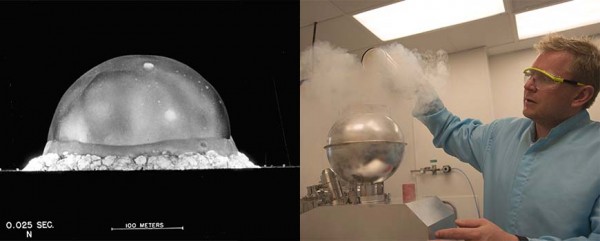By Ana Verayo, | February 10, 2017

Scripps Professor James Day analyzes glass formed from nuclear test explosion. (Scripps Institution of Oceanography at UC San Diego)
A new study has revealed some clues about how the moon was formed, based on a mineral that was first created from the first nuclear bomb test in 1945 called "trinitite." Scientists have now compared trinitite samples from the NASA Apollo moon mission and those from the earliest nuclear testing explosion decades ago to unravel the mystery of why the moon is vastly different from Earth, despite its proximity.
Like Us on Facebook
A team from Scripps Institution of Oceanography and the University of California San Diego re-examined the history behind man-made trinitite and its important link to the moon's evolution. The first atomic bomb was detonated in July 1945, at a desert outside New Mexico.
This nuclear bomb known as "Gadget" exploded and disintegrated a tower in a millionth of a second. This explosion released the equivalent of 22 kilotons of TNT. The countryside became so bright and more illuminated than a midday sun's rays.
Scientists and engineers were able to obtain chemical samples as the blast site was covered up to 1,200 feet with this green glass. This material is called trinitite, which is the first man made mineral that appeared on the sand of the desert's surface.
The heat was so extreme that samples of trinitite appear to have a reddish hue since it absorbed iron, lead and copper from the tower that disintegrated during the nuclear explosion. Temperatures were estimated to reach 8,157 degrees Celsius.
In this new study, researchers suggest how these type of conditions that created this man-made trinitite in the desert could be very similar to a planetary impact of a Mars-sized object that collided into Earth and formed the moon. Researchers say that the presence of zinc in both trinitite samples from lunar samples and the first nuclear bomb test can provide the key to the moon's mysterious formation.
During experiments, scientists from Scripps Institution of Oceanography collected trinitite samples from the Trinity test site in Alamogordo, New Mexico within 10 to 250 meters of ground zero. After running mass spectrometry tests to measure zinc isotopes from the samples, they discovered that zinc have dried out from the lunar samples and that there were less zinc content from the atomic blast.
According to John Day of the Scripps Institution of Oceanography, results reveal that there is an evaporation process during exposure to high temperatures that are strikingly similar to early planet formation. This leads to volatile elements being lost and enriching heavier isotopes from the remnants of the explosion.
Researchers then compared these isotope measurements from the New Mexico blast to lunar rock samples from the Apollo missions. Both samples showed lack of volatile elements with almost no water detected. This suggests that explosive events on the moon and on the first nuclear explosion had the same chemical processes at high temperatures, creating trinitite.
This new study was published in the journal, Science Advances.
-
Use of Coronavirus Pandemic Drones Raises Privacy Concerns: Drones Spread Fear, Local Officials Say

-
Coronavirus Hampers The Delivery Of Lockheed Martin F-35 Stealth Fighters For 2020

-
Instagram Speeds Up Plans to Add Account Memorialization Feature Due to COVID-19 Deaths

-
NASA: Perseverance Plans to Bring 'Mars Rock' to Earth in 2031

-
600 Dead And 3,000 In The Hospital as Iranians Believed Drinking High-Concentrations of Alcohol Can Cure The Coronavirus

-
600 Dead And 3,000 In The Hospital as Iranians Believed Drinking High-Concentrations of Alcohol Can Cure The Coronavirus

-
COVID-19: Doctors, Nurses Use Virtual Reality to Learn New Skills in Treating Coronavirus Patients







